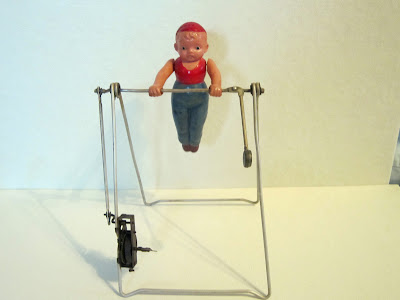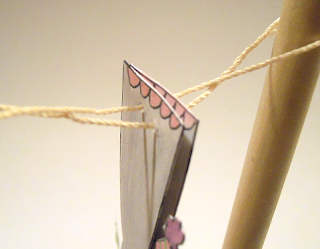I've always liked toys like this. Oddly, however, I don't own a single example. Since they look far easier to make than I expected, I decided to make one for today's elephant.
Trapeze toys—also known as gymnast toys—are, as the name suggests, toys in which a figure flips over a string between two struts. Although the most traditional versions of this toy are made of wood and/or cardboard, there are also versions made of tin or plastic, as well as motorized versions and versions made with plastic squeeze tabs.
 |
| Vintage Charlie Chaplin trapeze toy, 1920s. Source: http://chaplin.bfi.org.uk |
 |
| Motorized trapeze toy from Occupied Japan, 1940s. Source: http://www.ebay.com/itm/Celluloid-Windup-Toy-Arty- Trapeze-Artist-Occupied-Japan-1940s-Excellent-Cond-/290705534822 |
 |
| Vintage Disney-character trapeze toys with squeeze tabs. Source: http://www.rubylane.com/item/370999-2459/3- Different-Vintage-Disney-Character |
Oddly enough, I couldn't find anything online on the history of these toys. I also found only one set of instructions, in the video below. If you're contemplating trying this, the video gives you all the information you need.
I wasn't sure I liked the idea of using a cork for the body, as the video suggests—mostly because I didn't think I'd like the look of cardboard trunk and ears attached to a piece of cork. So I made everything out of cardboard. I was a bit concerned about what I'd use to attach the arms and legs to the body, but I was sure I could figure something out when the time came.
I started by making the uprights for the trapeze. I cut two pieces of 1 cm (3/8 inch) dowelling measuring approximately 26 cm (10.5 inches) in length, and one shorter piece measuring 7.5 cm (3 inches) in length. Although I chose dowelling, you could use any kind of straight stick.
I notched the tops of the two uprights to hold the trapeze string.
I then nailed the uprights to the crossbeam with 2.5 cm (1-inch) common nails. The idea is to make a lopsided "H".
Next, I made a sketch of the elephant on artist-quality bristol board. I then outlined everything with a pigment liner and heat-set it with a hairdryer. Before painting, I cut out all the elephant parts. I needed two arms, two legs and one body, all outlined on both sides.
I painted them on both sides with gouache so that the colours would be nice and bright.
I then pierced the elephant's "hands" in two places, by laying the hands on top of one another and driving a large needle through the two layers. These are the holes for the trapeze string. I also pierced the legs, arms and body so that the limbs could be attached to the body.
I now assembled the elephant, by attaching the legs and arms to the body. To attach the legs and arms to the body, I fed 28-gauge black-coated wire through the holes, then made a tight little coil on each side. It's important that the limbs swing freely.
To finish this up, I strung fine string through the holes in the hands and tied a knot at one side.
Finally, to assemble the toy, I flipped the trapeze section upside-down and inserted the uprights into the loops of string on either side of the hands. When the toy is flipped around, there is now a twist in the string, which is what allows it to leap up and down.
And here it is in action.
This was much easier than I expected it to be, although painting everything took a bit of time. However, the final result is quite fun. In fact, I might even make one or two of these as presents.
Elephant Lore of the Day
Just like human mothers-to-be, some elephants do prenatal exercises to ensure a healthy delivery.
At the Tierpark Hellabrunn Zoo in Munich, Germany, Panang the elephant was put through a daily series of stretching and strengthening exercises. The idea behind the regimen was to ensure that Panang's calf did not grow too big, while helping her to build up the muscles she'd need during delivery.
Zoo officials were particularly careful with Panang this time, because she had been pregnant twice before, but both calves were stillborn. Among elephants, stillbirths are actually quite common, with babies often becoming stuck between the womb and the pelvis. Some elephants have even been found to have carried mummified fetal remains in their bodies for years. Although emergency caesarean operations have been attempted on elephants, the procedure has so far always proven fatal to the mother.
Nor is the Munich zoo the only place to offer prenatal classes for elephants. At the Hamburg Zoo, also in Germany, prenatal exercise classes have become so popular with the elephants, that baby elephants often join in.
The idea has since spread to other zoos, where pregnant elephants are put through their paces, resulting in more live births, and less difficult labour for the mothers.
To Support Elephant Welfare

















No comments:
Post a Comment